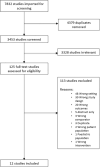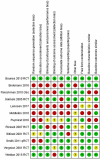Opioids for Treatment of Pre-hospital Acute Pain: A Systematic Review
- PMID: 35041151
- PMCID: PMC8861251
- DOI: 10.1007/s40122-021-00346-w
Opioids for Treatment of Pre-hospital Acute Pain: A Systematic Review
Abstract
Introduction: Acute pain is a frequent symptom among patients in the pre-hospital setting, and opioids are the most widely used class of drugs for the relief of pain in these patients. However, the evidence base for opioid use in this setting appears to be weak. The aim of this systematic review was to explore the efficacy and safety of opioid analgesics in the pre-hospital setting and to assess potential alternative therapies.
Methods: The PubMed, EMBASE, Cochrane Library, Centre for Reviews and Dissemination, Scopus, and Epistemonikos databases were searched for studies investigating adult patients with acute pain prior to their arrival at hospital. Outcomes on efficacy and safety were assessed. Risk of bias for each included study was assessed according to the Cochrane approach, and confidence in the evidence was assessed using the GRADE method.
Results: A total of 3453 papers were screened, of which the full text of 125 was assessed. Twelve studies were ultimately included in this systematic review. Meta-analysis was not undertaken due to substantial clinical heterogeneity among the included studies. Several studies had high risk of bias resulting in low or very low quality of evidence for most of the outcomes. No pre-hospital studies compared opioids with placebo, and no studies assessed the risk of opioid administration for subgroups of frail patients. The competency level of the attending healthcare provider did not seem to affect the efficacy or safety of opioids in two observational studies of very low quality. Intranasal opioids had a similar effect and safety profile as intravenous opioids. Moderate quality evidence supported a similar efficacy and safety of synthetic opioid compared to morphine.
Conclusions: Available evidence for pre-hospital opioid administration to relieve acute pain is scarce and the overall quality of evidence is low. Intravenous administration of synthetic, fast-acting opioids may be as effective and safe as intravenous administration of morphine. More controlled studies are needed on alternative routes for opioid administration and pre-hospital pain management for potentially more frail patient subgroups.
Keywords: Acute pain; Emergency medicine; Opioids; Pre-hospital.
© 2022. The Author(s).
Figures





References
-
- McLean SA, Maio RF, Domeier RM. The epidemiology of pain in the prehospital setting. Prehosp Emerg Care. 2002;6:402–405. - PubMed
-
- Jennings PA, Cameron P, Bernard S. Epidemiology of prehospital pain: an opportunity for improvement. Emerg Med J. 2011;28:530–531. - PubMed
-
- Galinski M, Ruscev M, Gonzalez G, et al. Prevalence and management of acute pain in prehospital emergency medicine. Prehosp Emerg Care. 2010;14:334–339. - PubMed
-
- McManus JG, Jr, Sallee DR., Jr Pain management in the prehospital environment. Emerg Med Clin N Am. 2005;23:415–431. - PubMed
Publication types
LinkOut - more resources
Full Text Sources

